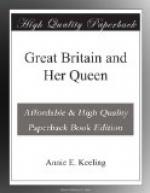“The Evangelical movement in the Church of England
was the direct result of his influence and example,
and since the movements and ideas which have moulded
the Church of England to-day could have found no fitting
soil for their development if they had not been preceded
by the Evangelical movement, it is no paradox to say
that the Church of England to-day is what it is because
John Wesley lived and taught in the last century....
He remains the greatest, the most potent, the most
far-reaching spiritual influence which Anglo-Saxon
Christianity has felt since the days of the Reformation.”
So far the
Times, of him whom it styles “the
restorer of the Church of England.” Many
impartial writers, some being ardent friends of the
English Church, have also recognised a gracious overflow
from Methodism which has blessed that Church, the
Nonconformist bodies, and the nation at large.
If a man would understand “the religious history
of the last hundred years,” that “most
important ecclesiastical fact of modern times,”
the rise and progress of Methodism, must be studied
in relation to the Anglican and the older Nonconformist
Churches, and the general “missionary interests
of Christianity”: so we are taught by Dr.
Stoughton, who has traced the influence of Methodism
in the general moral condition of the country and
the voluntary institutions of our age. The doctrines
once almost peculiar to Wesley and his followers—such
as entire sanctification—are now accepted
and taught by many Churches, and the religious usages
of Methodism are imitated, watchnight services being
held, and revival mission services and prayer-meetings
being conducted, in Anglican churches; while the hymns
of Charles Wesley, sung by all English-speaking Protestants,
and translated into many languages, enrich the devotional
life of the Christian world.
It was a fit tribute to the benefits which the English
Church has derived from the Methodist movement, when
the memorial tablet to the brothers John and Charles
Wesley was unveiled in Westminster Abbey by the late
Dean Stanley, in 1872.
“The bracing breezes,” said Dr. Stoughton,
“came sweeping down from the hills of Methodism
on Baptist meadows as well as upon Independent fields.”
We may give some few instances that will show what
blessings have come to Nonconformist Churches by the
agency of Methodism.
A remarkable incident that occurred in 1872 was recorded
in the Wesleyan Methodist Magazine. Dr.
Jobson had invited five eminent ministers to meet
the President of Conference at his house. After
breakfast their conversation quite naturally took the
form of a lovefeast, all being familiar with Methodist
custom; when Dr. Allon, Dr. Raleigh, and Dr. Stoughton
all said they were converted in Methodist chapels,
and began Christian work as Methodists. Thomas
Binney said that “the direct instrumentality
in his conversion was Wesleyan,” and Dr. Fraser
was induced to enter the ministry by a Wesleyan lady.




